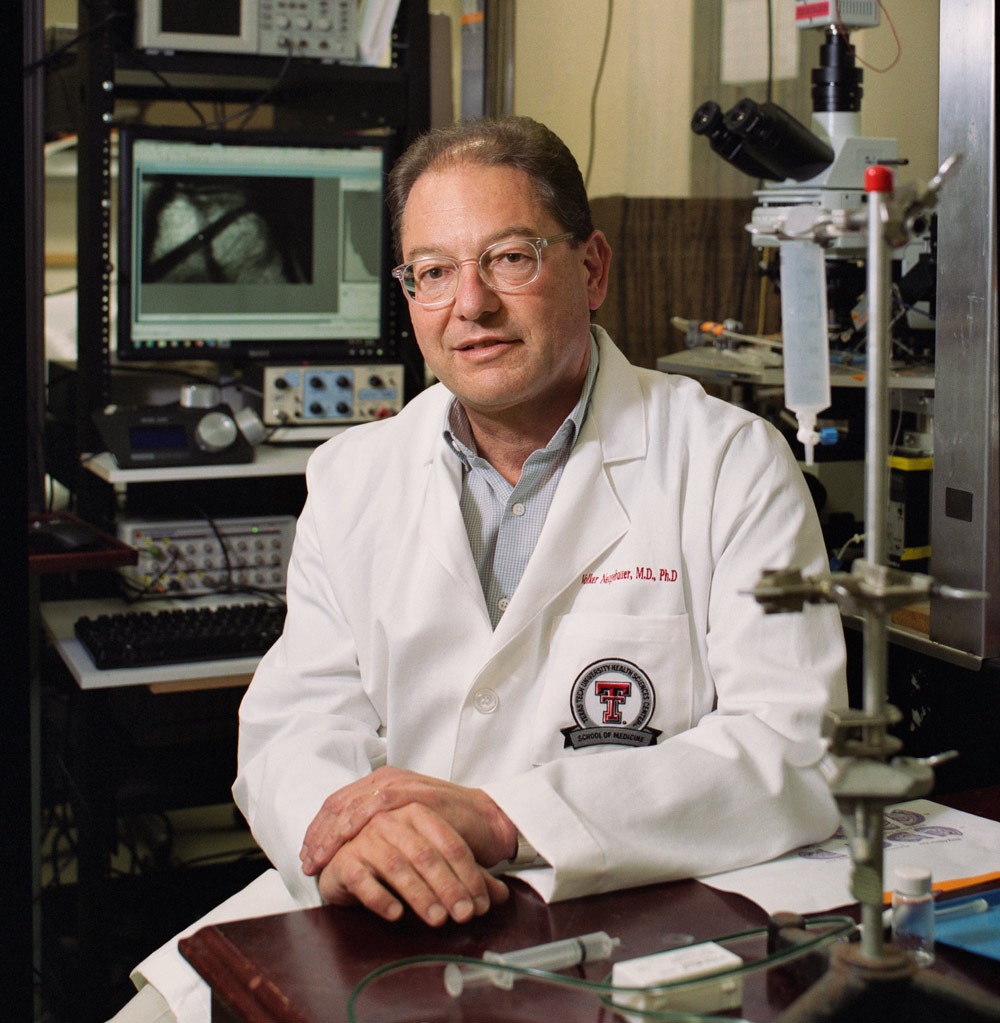 Feature
FeatureFrom Bedside to Bench

“I actually came from the humanities; I studied philosophy and theology as an undergraduate,” Neugebauer said. “I’m from Germany, and in that system, they frowned upon the empirical sciences that would just capture a very narrow aspect of the world versus philosophy and theology that deal with the world’s big questions.”
Following his undergraduate studies, Neugebauer, chair for the School of Medicine’s Department of Pharmacology and Neuroscience, considered teaching high school, going as far as enrolling in the graduate track for teaching. Then a newspaper ad, announcing a fast-approaching deadline for medical school applications, caught his eye.
“I thought about maybe practicing in the countryside, interacting with people beyond just medicine and answering questions in this classical patient-physician interaction,” Neugebauer recalled. “That was my goal suddenly, and I got accepted into medical school. I still had no real interest in science.”
During his first year of medical school, Neugebauer enrolled in a neuroscience course. The department chair was on sabbatical, so a visiting scientist taught the class. It was the 1980s, and rather than teaching the medical curriculum, his lectures focused on aspects of science, new at that time, such as neuroplasticity (growth and reorganization of the brain’s neural networks) and the NMDA (N-methyl-D-aspartate) receptors that act as the brain’s neurotransmitter for excitement.
Neugebauer found those topics very interesting, and as the semester entered its final few weeks, he was the only student still enrolled in the neuroscience class. He and the visiting instructor discussed philosophy and neurobiological sciences. They also considered neuroplasticity in the amygdala in the context of epilepsy, the only function for which that part of the brain was known at the time.
Neugebauer eventually enrolled in a graduate program for neuroscience and was captivated by working in a lab. However, his enthusiasm was tempered because pain was the only topic being investigated by all neuroscience graduate students.
Neugebauer began studying peripheral nerve fibers, which was as far removed from the complex brain functions in the body as he could imagine. “Because everybody in that graduate program did pain research, I felt like I was so far away from what I really wanted to do with these complex questions about neuroplasticity in the brain,” he said.
Neugebauer’s dissertation addressed spinal cord neuroplasticity in the context of pain. During that process, he began to appreciate the complexity of pain. He thought about ways he could add pain research to his primary interest in understanding the brain and its cognitive aspects.
“My eventual discovery of neuroplasticity in the amygdala in pain brought me close to fulfilling my dream about studying complex brain functions, such as feelings and thought processes,” Neugebauer added.
Although Neugebauer has researched other conditions such as addiction, epilepsy, schizophrenia, Parkinson’s disease and Alzheimer’s disease, the majority of his work has dealt with the relationship between pain and the amygdala.
“What makes pain unique is its unpleasantness,” Neugebauer said. “This is the emotional affective aspect of pain that cannot be explained in the peripheral nervous system or the spinal cord; it has to be in the brain, and the brain region that comes closest to encoding emotional affective aspects of things is the amygdala. I basically carved out my own niche by applying this to the pain field.”
Neugebauer has since become a renowned expert in pain research. It’s been a long road from a system that said such specialized scientific research provided an unrealistic and narrow view of the world. He occasionally reminds himself he once also felt that way.
“We need to put things in perspective when we do our work in the lab,” Neugebauer said. “Maybe it is a small part of the world, but we need to remember that a lot more could be out there than what we can capture in our experiments.”
– By Mark Hendricks
Dissecting the Grants
“Amygdala Pain Mechanisms” – Funded since 1999 to study the amygdala, a brain region known to be involved in emotions and affective disorders, and the role amygdala neuroplasticity (change and reorganization) plays in the transition from acute to chronic pain with a specific focus on neuroimmune signaling.
“A Prolactin-Mediated Neuroendocrine Link Between Stress-Induced Latent Sensitization and Female-Selective Pain” – Tests the novel hypothesis that chronic stress leads to increased release of prolactin, a female hormone that Neugebauer’s work has linked to pain responses.
“Stress-Induced Descending Facilitation from Amygdala Kappa Opioid Receptors in Functional Pain” – Demonstrating that blocking rather than activating kappa opioid receptors (KOR), which differs from receptors activated by morphine, is an effective strategy to reduce amygdala neuroplasticity and pain in stress-induced functional pain conditions.
Excerpts from the CURRICULUM VITAE of
Volker Neugebauer, MD, PhD
EDUCATION:
After medical school, he pursued residency training and then a postdoctoral fellowship, in Germany. He completed a second postdoctoral fellowship at the University of Texas Medical Branch in Galveston, on an National Institutes of Health National Institute on Drug Abuse training grant, after moving to the U.S. in 1995.
PRESENT POSITIONS
PUBLICATIONS, AUTHOR CREDITS, INVITED SPEAKING EVENTS
- 138 peer-reviewed research articles
- 26 book chapters and editorials
- 157 invited speaking events (off-campus)
- 8,892 citations
- h-index 57 (productivity and impact of a particular scientist or scholar)